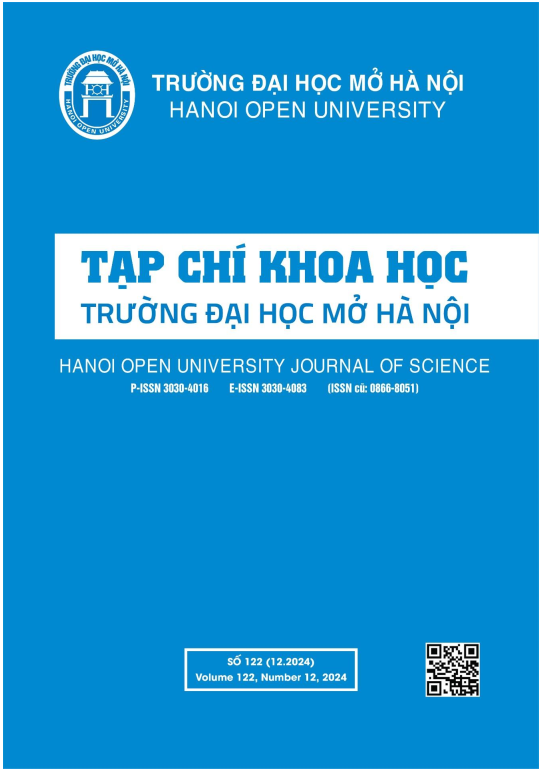VAI TRÒ TRUNG GIAN CỦA THÁI ĐỘ TRONG MỐI QUAN HỆ CỦA CÁC YẾU TỐ ẢNH HƯỞNG TỚI HOẠT ĐỘNG HỢP TÁC TRONG NGHIÊN CỨU KHOA HỌC CỦA GIẢNG VIÊN
DOI:
https://doi.org/10.59266/houjs.2024.509Keywords:
Hợp tác trong nghiên cứu khoa học, nhận thức lợi ích, năng lực nghiên cứu bản thân, văn hóa nhà trường, thái độAbstract
Nghiên cứu nhằm mục đích khám phá vai trò trung gian của thái độ trong mối quan hệ giữa các yếu tố ảnh hưởng đến hoạt động hợp tác nghiên cứu khoa học của giảng viên. Sử dụng phương pháp mô hình phương trình cấu trúc, nghiên cứu xác định văn hóa nhà trường, nhận thức lợi ích và năng lực nghiên cứu của bản thân giảng viên có ảnh hưởng đáng kể trực tiếp đến thái độ hợp tác trong nghiên cứu khoa học. Thái độ đóng vai trò trung gian, kết nối các yếu tố này với hoạt động hợp tác trong nghiên cứu khoa học của giảng viên. Những phát hiện này không chỉ đóng góp vào cơ sở lý thuyết về các yếu tố ảnh hưởng đến hoạt động hợp tác trong nghiên cứu khoa học mà còn cung cấp các hàm ý thực tiễn cho các cơ sở giáo dục đại học nhằm nâng cao chất lượng của hoạt động hợp tác nghiên cứu và gia tăng kết quả nghiên cứu khoa học của giảng viên.
References
[1]. Bhalla, S. (2023). Motivations and constraints of collaborative consumption, testing the mediating role of attitude and nature of trust. Vision, 27(2), 189-201.
[2]. Chu, T. H., & Chen, Y. Y. (2016). With good we become good: Understanding e-learning adoption by theory of planned behavior and group influences. Computers & Education, 92-93, 37–52. https://doi.org/10,1016/j. compedu.2015.09.013.
[3]. Davis, F. D. (1989). Perceived usefulness, perceived ease of use, and user acceptance of information technology. MIS Quarterly, 13(3), 319-340,
[4]. Dubey, P., & Sahu, K. K. (2021). Students’ perceived benefits, adoption intention and satisfaction to technology- enhanced learning: examining the relationships. Journal of Research in Innovative Teaching & Learning, 14(3), 310-328.
[5]. Garg, P., Gupta, B., Chauhan, A.K., Sivarajah, U., Gupta, S., & Modgil, S. (2021). Measuring the perceived benefits of implementing blockchain technology in the banking sector. Technological forecasting and social change, 163, 120407.
[6]. Hair, J. F., Hult, G. T. M., Ringle, C.M., & Sarstedt, M. (2017). A primer on partial least squares structural equation modeling (PLS-SEM) (2nd ed.). Thousand Oaks, CA: SAGE.
[7]. Henseler, J., Ringle, C. M., and Sarstedt, M. (2015). A new criterion for assessing discriminant validity in variance-based structural equation modeling, Journal of the Academy of Marketing Science, 43(1): 115-135
[8]. Lucas, M., & Vicente, P. N. (2023). A double-edged sword: Teachers’ perceptions of the benefits and challenges of online teaching and learning in higher education. Education and Information Technologies, 28(5), 5083-5103.
[9]. Moore, M. G. (2013). The theory of transactional distance. In M. G. Moore (Ed.) Handbook of distance education (3rd ed., pp. 66-85). New York, NY: Routledge.
[10]. Osman, Z., Nguyen, H.-A. T., Alwi, N. H., & Khan, B. N. A. (2024). Facilitating Collaborative Research in Online Open Flexible Distance Learning Higher Education Institutions. International Journal of Academic Research in Business and Social Sciences, 14(11), 2245–2263.
[11]. Pfundt, A., & Peterson, L. M. (2024). Self-efficacy and attitudes associate with undergraduates’ library research intentions: A theoretically-grounded investigation. Social Psychology of Education, 1-17.
[12]. Tasgin, A.(2018). Effective Participation and Motivation: An Investigation on Secondary School Students. World Journal of Education, v8 n1 p58-74 2018
